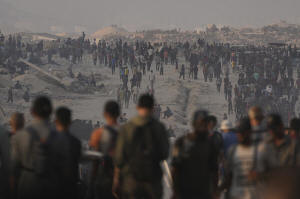Why there hasn't been a formal declaration of famine in Gaza
[July 30, 2025]
By JAMEY KEATEN and SAM MEDNICK
The leading international authority on food crises said Tuesday that the
“worst-case scenario of famine is currently playing out in Gaza." It
predicted “widespread death” without immediate action.
The Integrated Food Security Phase Classification, or IPC, said Gaza has
been on the brink of famine for two years, and that recent developments,
including “increasingly stringent blockades” by Israel, have
“dramatically worsened” the situation.
Even though Israel eased a 2 1/2-month blockade on the territory in May,
aid groups say only a trickle of assistance is getting into the enclave
and that Palestinians face catastrophic levels of hunger 21 months into
the Israeli offensive launched after Hamas' Oct. 7 attack.
Hundreds have been killed by Israeli forces as they try to reach aid
sites or convoys, according to witnesses, health officials and the
United Nations' human rights office. The military says it has only fired
warning shots.
The IPC warning stopped short of a formal declaration of famine. Here's
why:
The IPC and aid groups says Gaza's hunger crisis is worsening
Gaza’s population of roughly 2 million Palestinians relies almost
entirely on outside aid. Israel's offensive has wiped out what was
already limited local food production. Israel's blockade, along with
ongoing fighting and chaos inside the territory, has further limited
people's access to food.

The U.N. World Food Program says Gaza’s hunger crisis has reached “new
and astonishing levels of desperation." Nearly 100,000 women and
children are suffering from severe acute malnutrition, and a third of
Gaza’s population is going days without eating, Ross Smith, the agency’s
director for emergencies, said Monday.
The Gaza Health Ministry says there have been 82 malnutrition-related
deaths in Gaza this month, including 24 children. It did not give their
exact cause of death. The ministry, part of the Hamas-run government, is
staffed by medical professionals and its figures on war deaths are seen
by the U.N. and other experts as the most reliable estimate of
casualties.
Famine occurs when these conditions are met
The IPC was first set up in 2004 during the famine in Somalia. It
includes more than a dozen U.N. agencies, aid groups, governments and
other bodies.
Famine can appear in pockets — sometimes small ones — and a formal
classification requires caution.
The IPC has only declared famine a few times — in Somalia in 2011, and
South Sudan in 2017 and 2020, and last year in parts of Sudan’s western
Darfur region. Tens of thousands are believed to have died in Somalia
and South Sudan.
It rates an area as in famine when all three of these conditions are
confirmed:
— 20% of households have an extreme lack of food, or are essentially
starving.
— At least 30% of children 6 months to 5 years old suffer from acute
malnutrition, based on a weight-to-height measurement; or 15% of that
age group suffer from acute malnutrition based on the circumference of
their upper arm.
— At least two people, or four children under 5, per 10,000 are dying
daily due to starvation or the interaction of malnutrition and disease.
Gaza poses a major challenge for experts because Israel severely limits
access to the territory, making it difficult and in some cases
impossible to gather data.
The IPC said Tuesday that data indicate famine thresholds have been
reached for food consumption in most of Gaza, and for acute malnutrition
in Gaza City.

Famine declarations usually come from the UN or governments
While the IPC says it is the “primary mechanism” used by the
international community to conclude whether a famine is happening or
projected, it typically doesn’t make such a declaration itself.
Often, U.N. officials together with governments will make a formal
statement based on an analysis from the IPC.
[to top of second column]
|

Palestinians walk along a road toward an area in the northern Gaza
Strip where trucks are entering with humanitarian aid, in Gaza City,
Friday, July 25, 2025. (AP Photo/Abdel Kareem Hana)

But the IPC says once a famine is declared it's already too late.
While it can prevent further deaths, it means many people will have
died by the time a famine is declared.
It's not always clear that hunger is the cause of death
Most cases of severe malnutrition in children arise through a
combination of lack of nutrients along with an infection, leading to
diarrhea and other symptoms that cause dehydration, said Alex de
Waal, author of “Mass Starvation: The History and Future of Famine”
and executive director of the World Peace Foundation.
“There are no standard guidelines for physicians to classify cause
of death as ‘malnutrition’ as opposed to infection," he said.
When famine occurs, there are often relatively few deaths from
hunger alone. Far more people die from a combination of
malnutrition, disease and other forms of deprivation. All of these
count as excess deaths — separate from violence — that can be
attributed to a food crisis or famine, he said.
The war has made it hard to get accurate information
Israel's offensive has gutted Gaza's health system and displaced
some 90% of its population. With hospitals damaged and overwhelmed
by war casualties, it can be difficult to screen people for
malnutrition and collect precise data on deaths.
“Data and surveillance systems are incomplete and eroded," said
James Smith, an emergency doctor and lecturer in humanitarian policy
at the University College London who spent more than two months in
Gaza.
“Which means that all health indicators — and the death toll — are
known to be an underestimation,” he said.

Even when famine is declared, the response can be lacking
A declaration of famine should in theory galvanize the international
community to rush food to those who need it. But with aid budgets
already stretched, and war and politics throwing up obstacles, that
doesn't always happen.
“There is not a big, huge bank account” to draw on, said OCHA’s
Laerke. “The fundamental problem is that we build the fire engine as
we respond.”
Aid groups say plenty of food and other aid has been gathered on
Gaza's borders, but Israel is allowing only a small amount to enter.
Within Gaza, gunfire, chaos and looting have plagued the
distribution of food.
The international pressure led Israel to announce new measures over
the weekend, including daily humanitarian pauses in fighting in
parts of Gaza and airdrops of food. Israel says there’s no limit on
how many aid trucks can enter Gaza.
U.N. agencies say Israeli restrictions, and the breakdown of law and
order, make it difficult to distribute the food that does come in.
“Only a massive scale-up in food aid distributions can stabilize
this spiraling situation, calm anxieties and rebuild the trust
within communities that more food is coming,” the World Food Program
said. “An agreed ceasefire is long overdue.”
___
Associated Press writers Bassem Mroue in Beirut and Edith M. Lederer
at the United Nations contributed.
All contents © copyright 2025 Associated Press. All rights reserved |